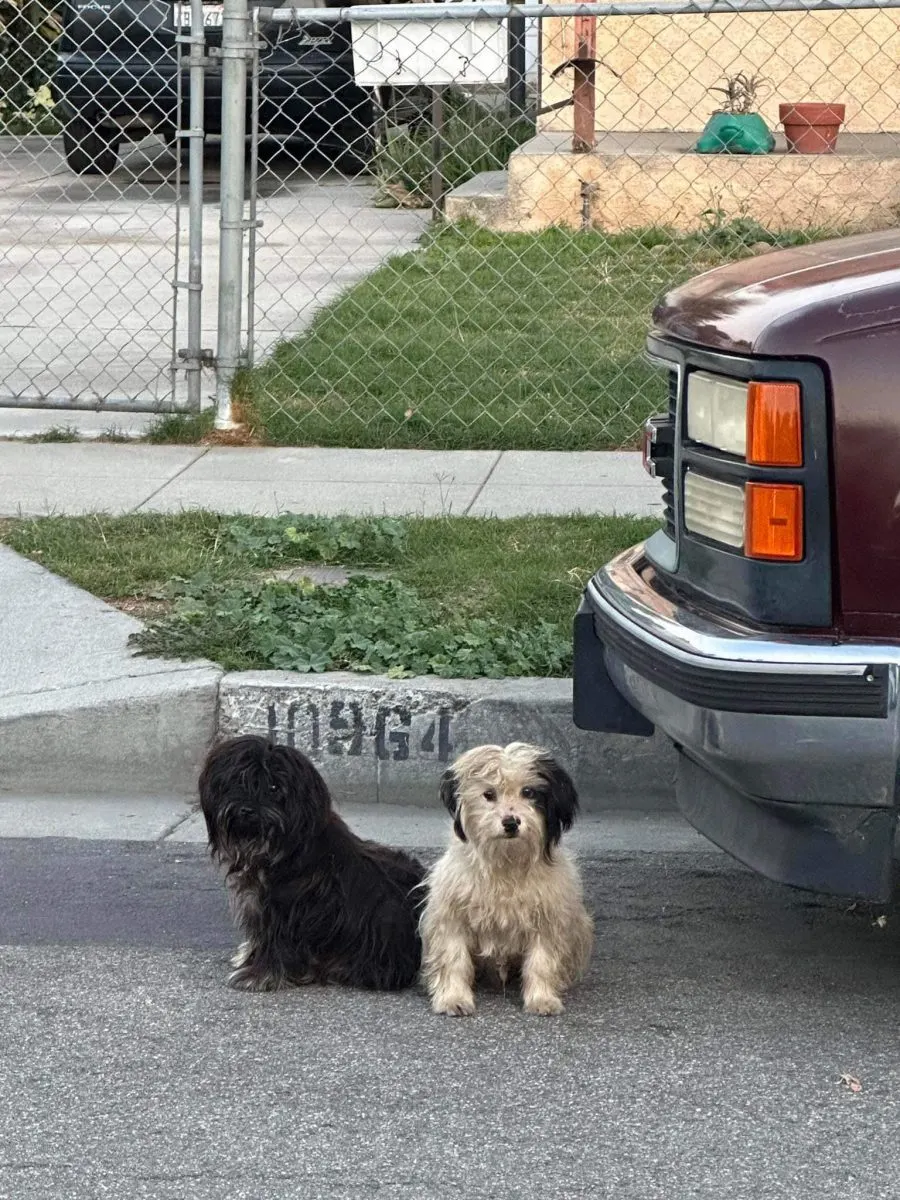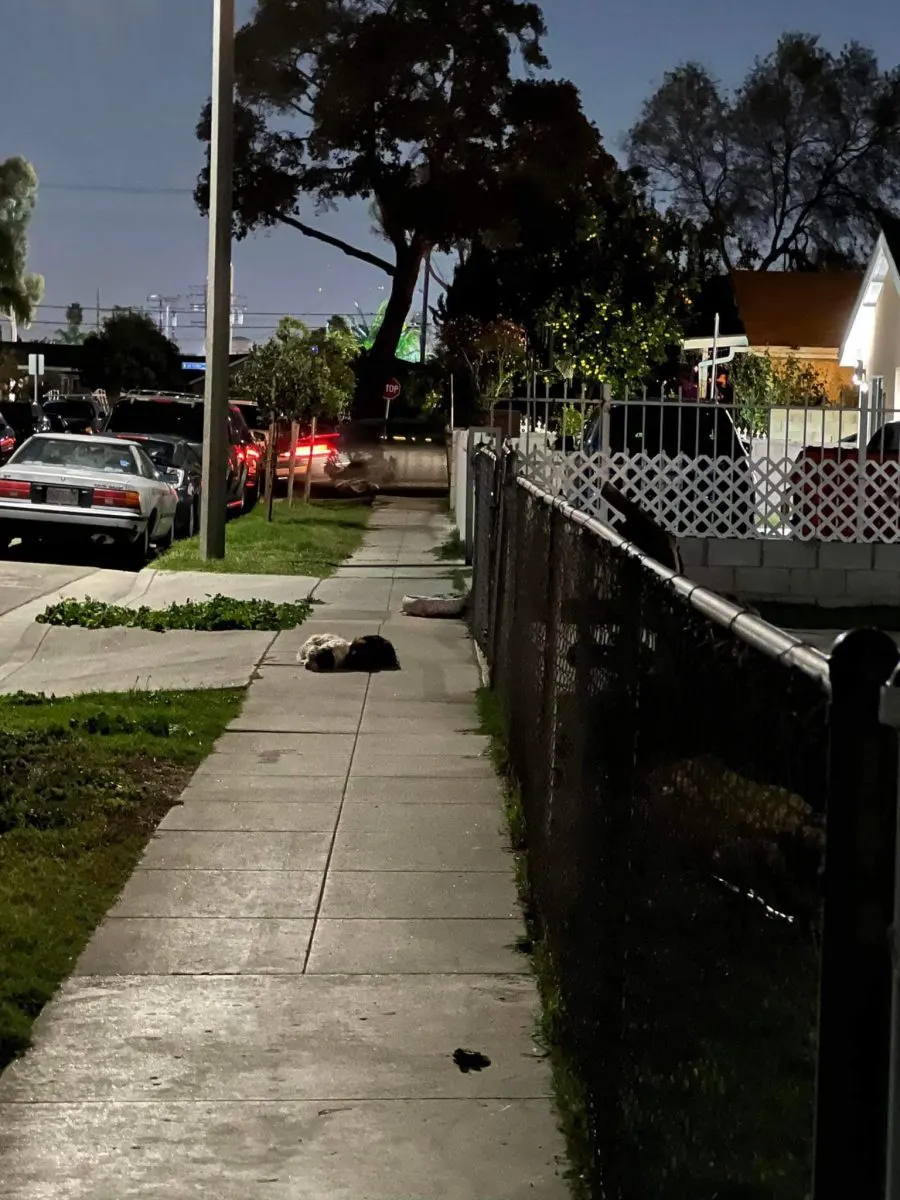When Suzette Hall, founder of a rescue organization in Irvine, California, by the name of Logan’s Legacy, picked up a call, she thought it would be information about a pup in need like every time before.
However, this time, it was different.
Determined Pups

Suzette found out about two small pups wandering around a neighbourhood with a very concerning attitude and behaviour.
It had seemed that the dogs were abandoned by their previous family, not wanting to move from their spot or be apart for even one second.
“They would literally follow each other up the street and then back to their spot. They never, ever, ever left each other’s side,” Suzette told The Dodo.
The neighbours tried their best to lure the pups, later named Pongo and Lilly, into their own homes, wanting to provide them shelter, but the pups simply refused to move an inch.

In their final attempt to help these pups, the neighbours set up a bed for the pups, along with some food and water, and then they contacted every rescue they could, one of them being Logan’s Legacy.
Rescue Mission
Right away, Suzette realized that this would not be an easy rescue at all since she knew that two pups were much harder than catching one.
Luckily, she was not alone. Another rescuer named Chloe offered to help as well.
“I realized an amazing rescuer, Chloe, was asking for fosters for them. Thank goodness Chloe and I connected. There’s nothing better than rescuers working together to save lives,” she added.
The incredible rescue teams joined forces and immediately made their way to the location.

They decided to set up a humane dog trap with some yummy treats, as they thought this would be the easiest way to capture them. And, they were right… Lilly and Pongo approached the trap as soon as they noticed them.
“Pongo went in so fast, but the tiny black one [was] so weary. But she stayed right by her friend,” stated Suzette.
Lily stayed by Pongo’s side. However, after some time, she decided to wander off into an adjacent yard.
The rescuers decided to get some baby gates and follow her paw steps.
When Lilly saw them approaching, she quickly bolted under a car, seeking shelter, leaving the rescuers with the perfect opportunity to surround her with baby gates, making sure she wouldn’t escape again.
As soon as they managed to capture her, they reconnected her with her best friend.
“It was so cute to see how bonded these two were. They were skinny, scared and sweet all at the same time,” she added.
The adorable pups managed to find foster care right away who gave them much-needed baths and haircuts.
Final Word
Today, Lily and Pongo are thriving in the foster homes that provide them with everything they need and so much more.
They are still looking for their forever home as a package deal, and I believe being the pawdorable duo that they are, they will find one in no time!
But, their rescue wouldn’t be possible without the amazing efforts of the local rescue teams. Incredible teamwork was done by incredible people.
Good job, guys!
Ever wondered why your furry companion can’t indulge in a piece of chocolate like you do? As a seasoned dog trainer, you’re well aware of the importance of understanding what’s safe and what’s off-limits for your four-legged friend. Chocolate, a beloved treat for many, holds a hidden danger for dogs that can’t be ignored.
Your canine pal’s inability to enjoy chocolate isn’t just a matter of preference; it’s a matter of health and well-being. While you might savor the rich taste of chocolate, it’s crucial to recognize the potential risks it poses to your loyal companion. So, let’s uncover the reasons behind why dogs and chocolate simply don’t mix, shedding light on this common but harmful misconception.
Understanding Chocolate Toxicity in Dogs
The Role of Theobromine
Theobromine is a substance found in chocolate that dogs cannot metabolize effectively. It stays in their system for an extended period, leading to toxic effects. Even small amounts of theobromine can cause adverse reactions in dogs.
Symptoms of Chocolate Poisoning in Canines
If your dog ingests chocolate, watch out for symptoms like vomiting, diarrhea, restlessness, increased heart rate, and even seizures. These signs indicate chocolate poisoning and require immediate veterinary attention to prevent further complications.
Types of Chocolate and Their Hazards
Milk Chocolate Versus Dark Chocolate
When it comes to dogs and chocolate, the type matters. Milk chocolate has lower levels of theobromine compared to dark chocolate. While any chocolate can be harmful to your furry friend, milk chocolate contains less theobromine, making it generally less toxic than its darker counterpart. However, it still poses a risk and should be kept away from your dog to prevent any health issues.
White Chocolate: A Lesser Threat?
Although white chocolate contains very little theobromine, it still has other ingredients like sugar and fats that can be harmful to dogs in large quantities. While it is considered the least toxic of all chocolate types for dogs due to its low theobromine content, it’s essential to remember that any amount of chocolate can be dangerous for your pet. It’s best to err on the side of caution and keep white chocolate, along with all other types, out of your dog’s reach to ensure their well-being.
How Much Chocolate Is Too Much for Dogs?
Calculating The Toxic Dose
Toxicity in dogs is related to the amount of theobromine they ingest. A general guideline is that ingestion of over 20 milligrams of theobromine per kilogram of a dog’s body weight can be toxic. For example, if your dog weighs 10 pounds (around 4.5 kilograms), consuming more than 90 milligrams of theobromine could be harmful.
Factors Affecting Chocolate Toxicity
Several factors can influence how a dog reacts to chocolate ingestion. These include the type of chocolate eaten, the dog’s size and age, as well as its overall health condition. Dark chocolate has higher theobromine levels than milk chocolate, making it more dangerous. Smaller dogs are at a higher risk as a smaller amount of theobromine can be toxic for them. Older dogs or those with existing health issues may also be more vulnerable to the effects of theobromine.
It’s crucial to be aware of the potential dangers of chocolate for dogs. Keeping all types of chocolate out of reach of your furry companion is the best way to prevent any accidental ingestion and ensure their well-being. If you suspect your dog has consumed chocolate or is showing symptoms of poisoning, seek immediate veterinary assistance to address the issue promptly.
What to Do If Your Dog Eats Chocolate
Immediate Steps to Take
If your dog ingests chocolate, the first thing to do is to stay calm. While it can be alarming, panicking won’t help. Immediately remove any leftover chocolate to prevent further consumption. Next, check the type of chocolate your dog ate and estimate the amount if possible. This information will be useful for the vet.
When to Seek Veterinary Help
It’s crucial to contact your vet or an emergency animal poison control hotline as soon as you suspect your dog has eaten chocolate. Depending on the amount ingested and your dog’s size, theobromine toxicity can escalate quickly. Even if your dog shows no immediate symptoms, it’s best to seek professional guidance to ensure their well-being. Remember, early intervention can prevent serious complications.
Preventing Chocolate Accidents
Safe Storage Tips
When it comes to keeping your furry friend safe, storing chocolate out of reach is crucial. Ensure all chocolate products are securely stored in cabinets or places your dog can’t access. Remember, dogs have a keen sense of smell, so even hiding chocolate on a high shelf may not be enough to deter them. Be vigilant about where you keep chocolate to prevent any accidental ingestion.
Educating the Family About Chocolate Risks
Educating your family members about the dangers of chocolate for dogs is essential. Make sure everyone in the household knows the risks associated with feeding chocolate to dogs and the importance of keeping it away from them. It’s not just about avoiding feeding chocolate intentionally; accidental ingestion can also happen if everyone isn’t aware of the risks. Take the time to educate your loved ones to create a safer environment for your canine companion.
Conclusion
Remember, chocolate can be harmful to your furry friend due to the theobromine it contains. It’s crucial to keep chocolate out of your dog’s reach to prevent any accidental ingestion. If your dog consumes chocolate, immediate veterinary attention is essential. Factors like the type of chocolate and your dog’s size and health can impact the severity of poisoning. Dark chocolate poses a higher risk, especially for smaller or older dogs. Stay informed, educate your family about the dangers of chocolate for dogs, and take proactive steps to create a safe environment. By being cautious and aware, you can help keep your canine companion healthy and happy.
Frequently Asked Questions
Is chocolate harmful to dogs?
Yes, chocolate is harmful to dogs due to the presence of theobromine, which can be toxic and lead to symptoms like vomiting, diarrhea, and seizures.
What should I do if my dog eats chocolate?
Seek immediate veterinary care if your dog eats chocolate as theobromine poisoning can be life-threatening, especially depending on factors like the type of chocolate, your dog’s size, age, and health condition.
Why is dark chocolate more dangerous for dogs?
Dark chocolate contains higher levels of theobromine compared to milk chocolate, posing a greater risk of poisoning, especially for smaller or older dogs.
How can I prevent chocolate poisoning in dogs?
Prevent chocolate accidents by storing chocolate securely out of reach of pets, educating family members about the risks, and being vigilant about chocolate ingestion to create a safer environment for your canine companions.
[no_toc]

Hey there, I’m Janet Brooks, a dog-loving student from California. I’m all about helping pups in need, especially those without homes. Me and my awesome friends work together to give shelter and love to stray dogs. Oh, and I also write blogs about dogs to share helpful info.